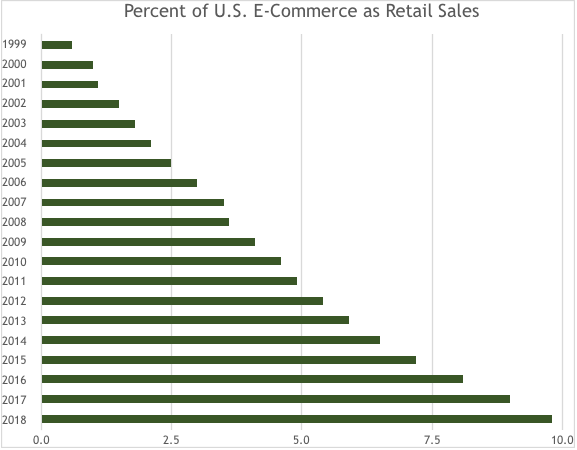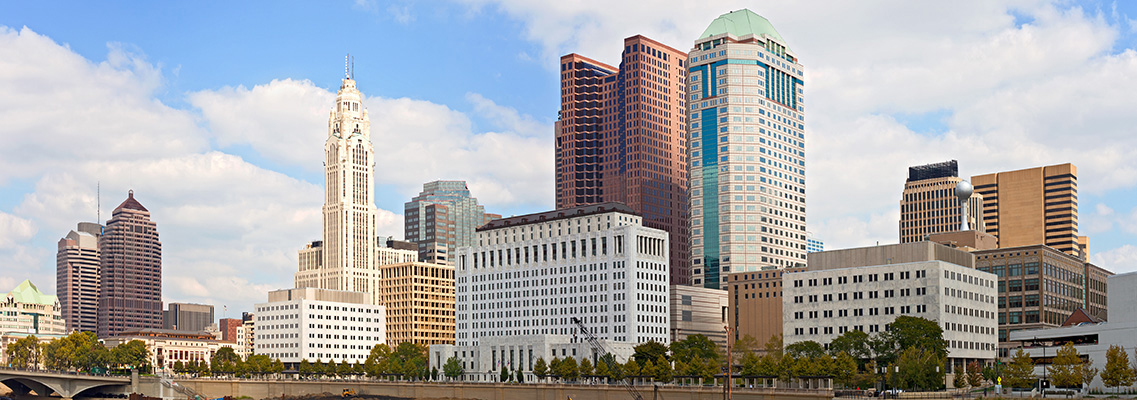The steady growth in e-commerce will not only continue in 2019 but will increase as more shoppers look to their computer and not their car to drive to the mall to buy their goods and services. The Census Bureau of the Department of Commerce estimated that in the third quarter of 2018 e-commerce retail sales totaled $130.9 B which constituted an increase of 3.1 % from the second quarter of 2018. Third quarter 2018 e-commerce retail sales estimate increased 14.5 % from the third quarter of 2017 while total retail sales increased 5.3 percent in the same period.

As the chart above illustrates, on-line ecommerce is illustrating strong growth year after year as a total percentage of U.S. retail sales. While Census data on the 2018 Holiday season are not in yet, Cyber Monday sales this year surged to new highs, with a record $7.9 billion spent online that day, an increase of 19.3 percent from a year ago, according to data from Adobe Analytics. More importantly, while in-store retail sales on Black Friday set a spending record of $6.22 B this total is now far lower than on-line sales on Cyber Monday.
Traditional brick and mortar retail stores are certainly not dead but survival for many will depend upon their ability to deliver goods through an e-commerce platform whether that is tied to in-store pickup or home delivery. That new delivery model creates substantial new opportunities for the development of logistics, fulfillment and distribution centers. NAOIP reports over the last two years, e-commerce logistics real estate was the most active industrial sector in the United States, and it represented 22.5 % of all big-box leases of 500,000 square feet or more– that’s up from 16.1 percent of all big-box transactions from 2010 to 2014, when e-commerce was the third most-active industrial sector. According to Jones Lang LaSalle, the global logistics markets maintained their momentum through the third quarter of 2018, with record demand holding vacancy levels near historic lows despite an expanding supply pipeline, and net absorption in the U.S. industrial market rose to its highest level of the year during Q3, with annual rental growth accelerating to 6.3% despite an increase in new completions. CBRE reports that demand for warehouse workers is growing faster than the labor supply, and that could drive up costs for fulfillment center operations as digital commerce becomes a bigger force in retail sales. According to a recent CBRE Group, report U.S. warehouses and distribution centers need an additional 452,000 workers in total this year and next illustrating the critical role workforce development will play for companies and regions considering expansion in this growing industry sector.
E-commerce and automation are making logistics and distribution centers the starting point for large scale economic growth. Look at Ohio, Columbus is passing by Cincinnati and Cleveland related to population and economic growth. While logistics and distribution growth is not the only reason for Columbus’ success, the growth in this sector driven by the creation of the Rickenbacker Logistics Park and other logistics centers is part of the reason for their economic success.
Logistics/Distribution Workforce Wage & Jobs Regional Comparison

As the table above illustrates, Franklin County, home to Columbus, has substantially more workers in the Trade and Materials Moving occupation category compared to their major Ohio urban counterparts of Cleveland and Cincinnati. Also assisting the growth of Columbus is the fact that the region actually employs more its residents in logistics than in manufacturing. Due in large part to automation, the manufacturing sector is employing fewer and fewer Americans while the growth in logistics jobs is on the rise.
